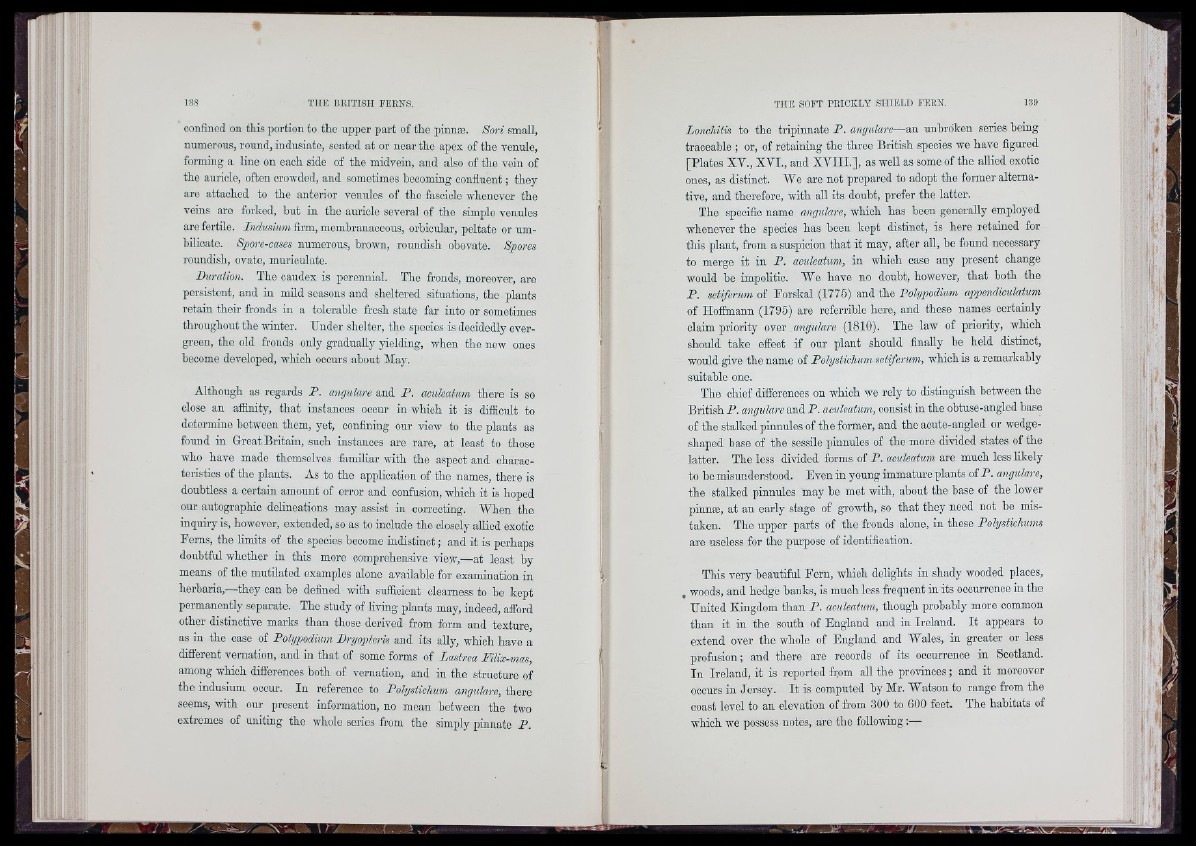
i.l
: !!
S 1
A i U
§
confined on this portion to the npper part of the pinnæ. Sort small,
numerous, round, indusiate, seated at or noar the apex of the venule,
forming a line on each side of the midvein, and also of the vein of
the auricle, often crowded, and sometimes becoming confluent ; they
are attached to the anterior venules of tho fasoiolo whenever the
veins are forked, but in the auricle several of tho simple venules
are fertile. Indusium firm, mombranacoous, orbicular, peltate or um-
bilioato. Spore-cases numerous, brown, roundish obovate. Spores
roundish, ovate, muriculate.
Duration. The caudox is perennial. The fronds, moreover, are
persistent, and in mild seasons and sheltered situations, the plants
retain their fronds in a tolerable fresh state far into or sometimes
throughout the winter. Under shelter, tho species is decidedly evergreen,
the old fronds only gradually yielding, when the now ones
become developed, which occurs about May.
Although as regards P . angulare and P . aculeatum there is so
close an affinity, th a t instances occur in which it is difficult to
determine between them, yet, confining our view to the plants as
found in Groat Britain, such instances are rare, at least to those
who have made themselves familiar with the aspect and oharao-
teristios of the plants. As to the application of the names, there is
doubtless a certain amount of error and confusion, which it is hoped
our autographic delineations may assist in correcting. When the
inquiry is, however, extended, so as to include the closely allied exotic
Ferns, the limits of the species become indistinct; and it is perhaps
doubtful whether in this more comprehensive view,—at least by
means of the mutilatod examples alone available for examination in
herbaria,—they can be defined with sufficient clearness to bo kept
permanently separate. The study of living plants may, indeed, afford
other distinctive marks than those derived from form and texture,
as iu the case of Polypodium Dryopteris and its ally, which have a
different vernation, and in that of some forms of Lastrea Filix-mas,
among which differences both of vernation, and in the structure of
the indusium occur. In reference to Polystichum angulare, there
seems, with our present information, no mean between the two
extremes of uniting tho whole series from the simply pinnate P .
Lonchitis to the tripinnate P . angulare—an unbroken series being
traceable ; or, of retaining the three British species we have figured
[Plates XV., XVI., and X V III.], as woll as some of the allied exotic
ones, as distmct. We are not prepared to adopt the former alternative,
and therefore, with all its doubt, prefer the latter.
The specific name angulare, which has been generally employed
whenever the species has been kept distinct, is here retained for
this plant, from a suspicion that it may, after all, he found necessary
to merge it in P . aculeatum, in which case any present change
would be impolitic. We havo no doubt, however, that both the
P . setiferum of Forskal (1775) and the Polypodium appendiculatum
of Hoffmann (1795) are referrible hero, and these names certainly
claim priority over angulare (1810). The law of priority, which
should take effect if our plant should finally he held distinct,
would give the name of Polystichum setiferum, which is a remarkably
suitable one.
The chief differences on which wo rely to distinguish between the
British P . angulare and P . a.euleatum, consist in the obtuse-angled base
of the stalked pinnules of the former, and the acute-angled or wedge-
shaped base of the sessile pinnules of the more divided states of the
latter. The less divided forms of P . aculeatum are much less likely
to be misunderstood. Fven in young immature plants of P . angulare,
the stalked pinnules may he met with, about the base of the lower
pinnæ, at an early stage of growth, so that they need not be mistaken.
The upper parts of the fronds alone, in these Polystichums
arc useless for the purpose of identification.
This very beautiful Fern, which delights in shady wooded places,
, woods, and hedge banks, is much less frequent in its occurrence in the
United Kingdom than P . aculeatum, though probably more common
than it in the south of England and in Ireland. I t appears to
extend over the whole of England and Wales, in greater or less
profusion; and there are records of its occurrence in Scotland.
In Ireland, it is reported from all the provinces ; and it moreover
occurs in Jersey. I t is computed by Mr. Watson to range from the
coast level to an elevation of from 300 to 600 feet. The habitats of
which we possess notes, are the following :—
i i